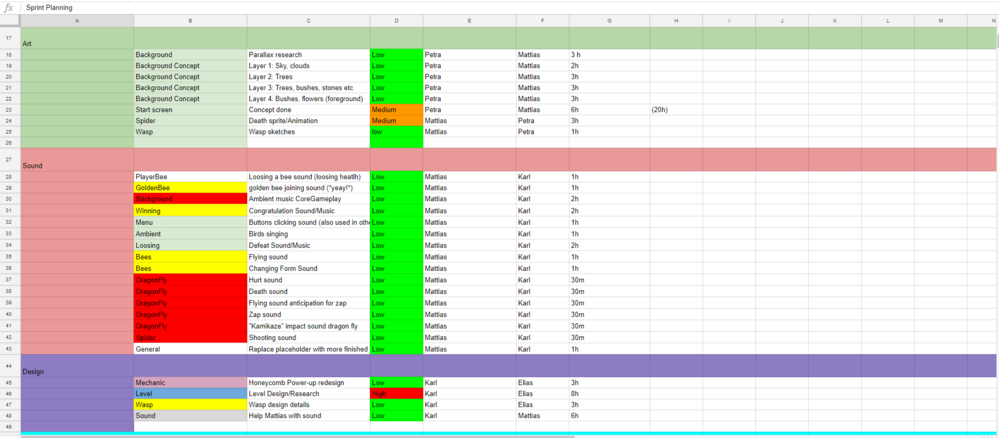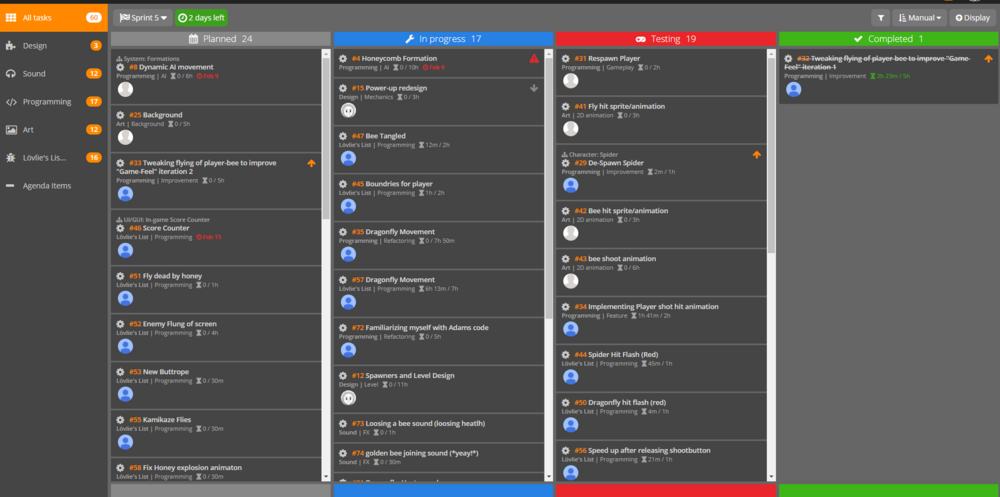Working with Scrum
Hello again! In this weeks blog post I will discuss my experiences as a team member from working with the Scrum toolkit during the development of our game. I will explain what Scrum is and how our team has implemented and used it, as well as my own experiences as an individual team member.
Scrum is a working toolkit that was first introduced to our groups Project Manager in his minor and then from our Project Manager to the rest of our group.
Scrum itself is a framework and philosophy that can be used by teams to work as productively as possible and use the most of their time in the most productive way.
Using Scrum, each week for our team starts on Monday with a ”Sprint Planning” where the team has a meeting where we discuss where we are and decide what should be done during the week. This is known as a ”Sprint”. It’s the planned amount of work from Monday to Friday. Using an excel document on Google Drive, the work is seperated into the team members individual minors, as seen in the example picture below:

The questions of who gets what work is something that is discussed amongst the team members. Perhaps the programmers are in need of specific design decisions which then needs to be prioritized by the designer.
Next in line on the picture is the ”risk” of the work. This can be seen as the difficulty the person responsible might have with the work. If the person has never done a specific kind of work then that would be considered a high risk for possible problems.
Each task also has a time estimation set by the person responsible for that task. A preferable total time for each member during each sprint, which is from monday to friday, is at least 20 hours. That would mean at least four hours each day focused on the Sprint workload.
When the Sprint Planning is concluded the Sprint for the week has officaly started. Each day the team have a ”Daily stand-up meeting”. This is a short daily meeting where we discuss what we did yesterday and what we plan on doing today. It is very useful because we can talk about what problems might’ve arisen during the previous days work.
At the end of the week, on Friday, we have a ”Sprint review”. This is where we sit down and discuss what we got done during the whole week. What tasks that we set at the start of the week were we able to finish and how did it go? Did anything not get finished? Why? What other problems and issues do each member have? We then decide that the work week is finished. If any member wishes to work during the weekend that member is of course free to do so, but the optimal goal with the Sprints is to be able to work as productive as possible from Monday to Friday and have the weekend to rest.
Besides Google Drive, our team uses an online software called ”HacknPlan”. Within Hacknplan we can keep track of each others work, what we’re currently working on, what we’re going to work on next and what work we have finished. This is very useful since the work of the whole team is dependent on each other. An example of how this looks can be seen below:

From a personal perspective as the Designer of the team, Scrum has been a very positive and well working framework. It has introduced an organized and clear structure to my own work as well as a good teamwork with the other members of the team. I’ve also felt a sense of constant progression during the work since I can follow the teams progress and get response on my own work at any time.
I have never worked like this before and it has been a very positive experience so far and I think it will continue to evolve within our team and become even better!
// Karl Lindkvist
In your blog, you explain everything very thoroughly which makes it very easy to read and follow. If I were someone who didn’t know about Scrum I would still understand the parts you’ve explained. It’s a very well written and structured blog.
I can’t really seem to find any issues with it, I had no problems whatsoever understanding what you wanted to express. You’ve also included pictures of how the Scrum tools you use look like. This, combined with the information you have given the reader, makes it incredibly easy to understand what Scrum is, and how it works.
You also describe when certain things are useful and why such as the daily stand-up meetings allow you to see if anyone has any problems and you can, therefore, stop it before it slows down the project. The last part that I find very positive on your blog is the placement of your pictures.
They are placed in such a way that it doesn’t interrupt my reading in any way but it instead adds to the information you’ve already given.
GillaGilla